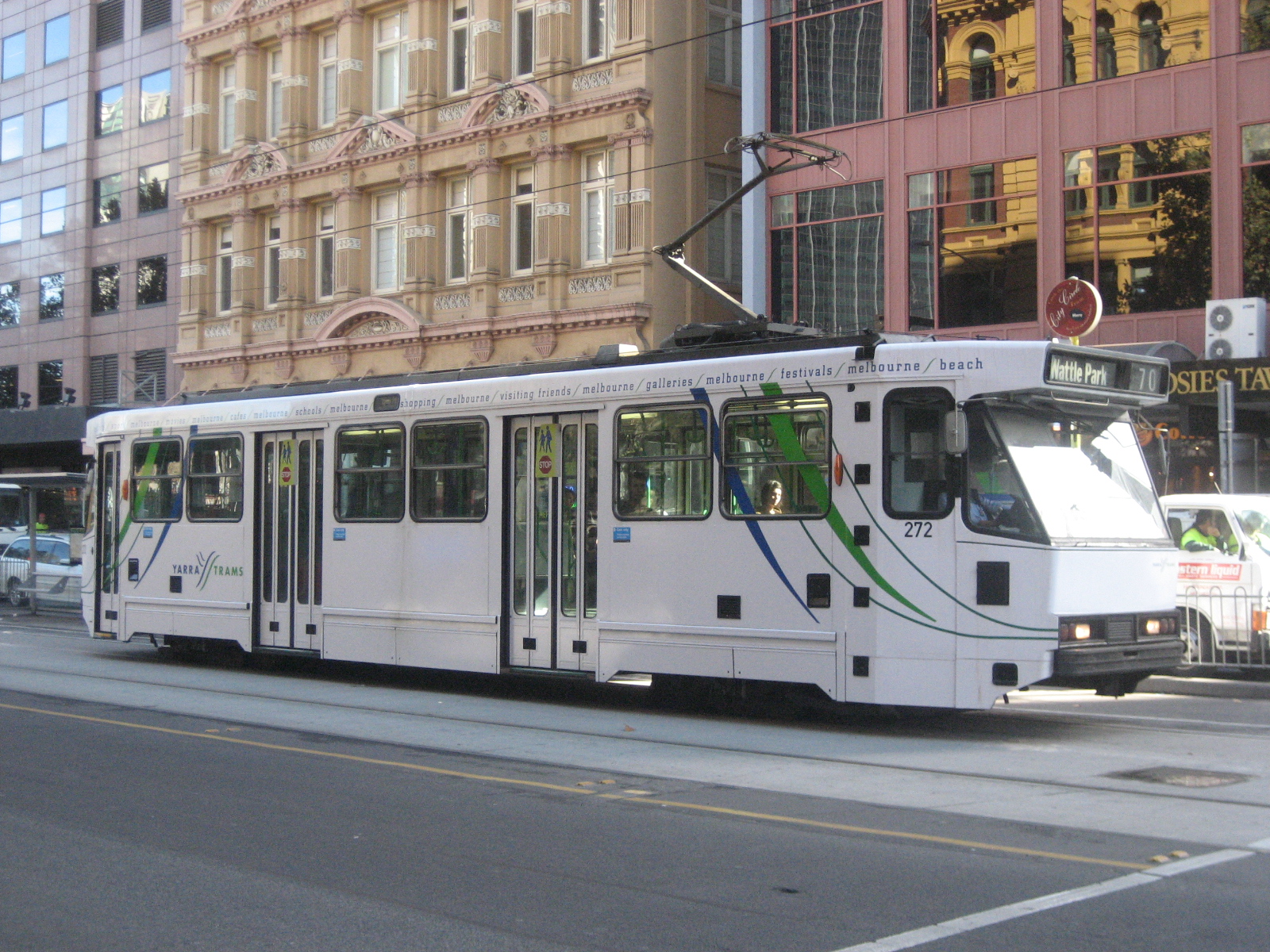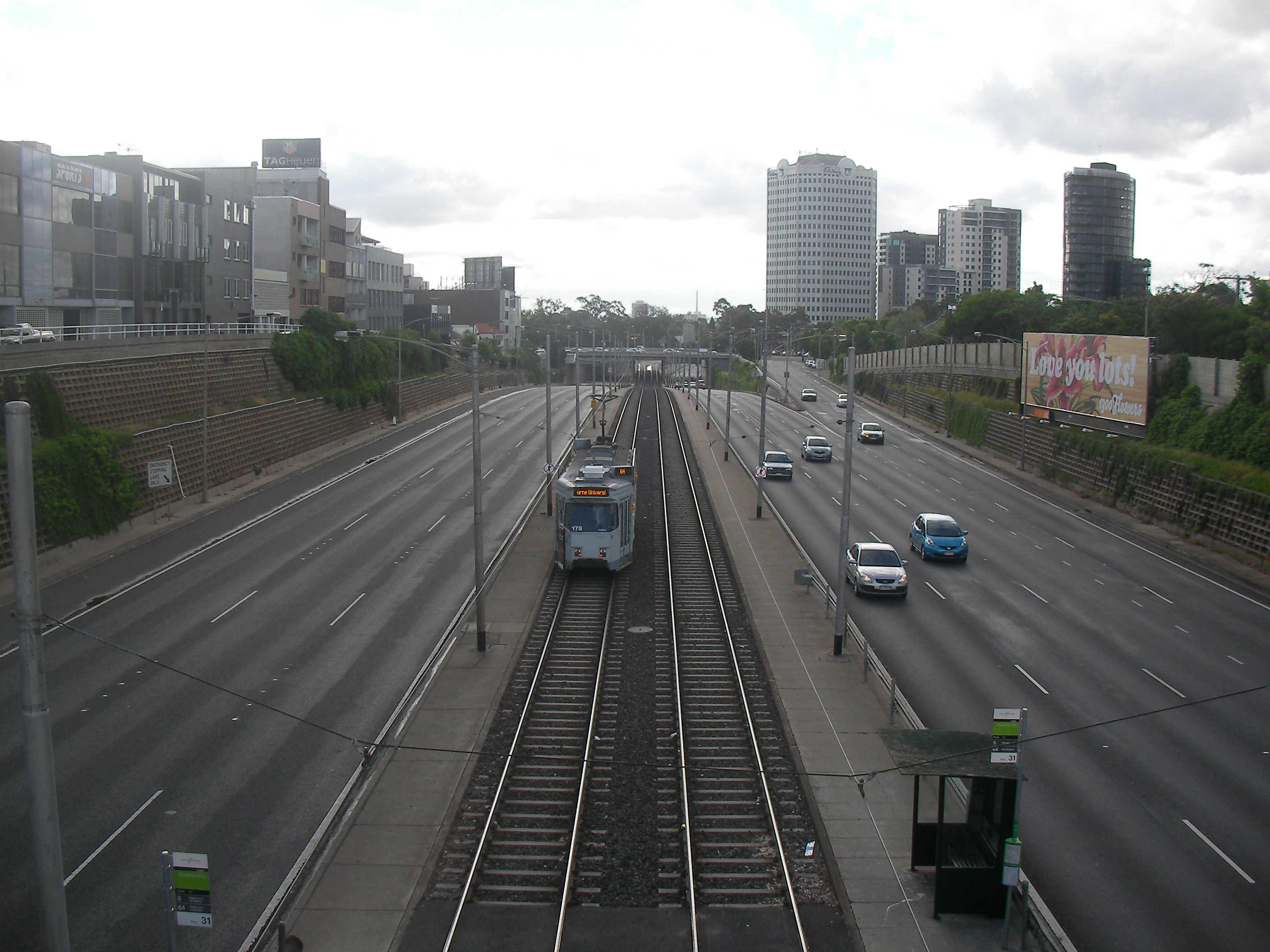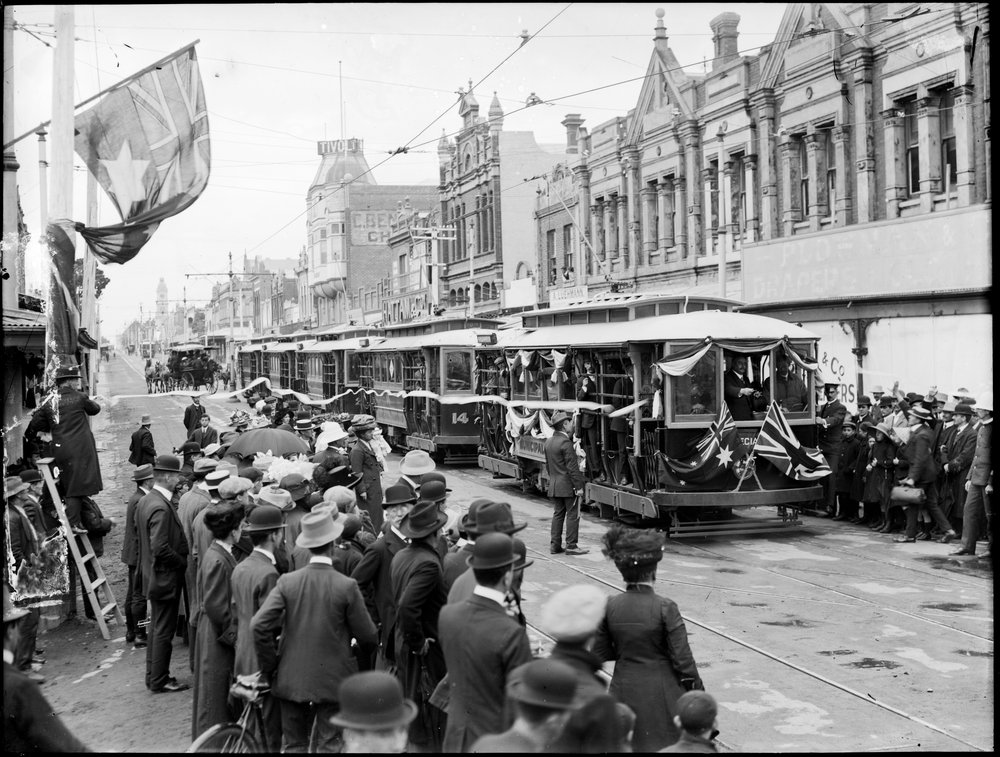|
Melbourne Tram Route 64
Melbourne tram route 64 is operated by Yarra Trams on the Melbourne tram network from Melbourne University to Brighton East. The 18.1 kilometre route is operated out of Glenhuntly depot with Z and B class trams. After 19:00, passengers for route 5 to Malvern are required to board route 64 (marked 64/5) and transfer to route 5 shuttles on Dandenong Road. History Route 64 was allocated to the line between Brighton East and City (Swanston Street) on 16 October 1938. Prior to that, Route 64 was allocated to the line between Brighton East and St Kilda Beach via St Kilda Junction. Between 1938 and 9 July 1955, Route 64 ran via Balaclava Road rather than Dandenong Road. Trams traditionally terminated at the Victoria Street terminus, but following an accident in 1991, trams instead terminated at the Queensberry Street crossover. Due to congestion during peak hours at the crossover, some trams continued north to Melbourne University. Finally on 17 January 1996, a permanent shunt wa ... [...More Info...] [...Related Items...] OR: [Wikipedia] [Google] [Baidu] |
A-class Melbourne Tram
The A-class Melbourne tram is a class of bogie trams that operate on the Melbourne tram network. Seventy were built by Comeng, Dandenong between 1984 and 1987 in two batches, 28 A1's and 42 A2's, with only minor differences. They are the smallest trams by capacity currently operating on the network. History Comeng had expected an extension to the Z-class order, and in the early 1980s drew up plans for a Z4-class, due to a change in state government in 1982 these plans were put on hold. The order eventuated however in late 1982, for 28 A1-class trams. (at the same time, an order was placed for two B1 class articulated LRVs, making a total of 30 trams ordered). The design, which was shaped by input from passengers and tramway employees, had a series of alterations from the Z-class design. They did not include the conductors console seen in the Z-class, and had a differing door arrangement that posed a design challenge, as there was less space to house equipment. This order ... [...More Info...] [...Related Items...] OR: [Wikipedia] [Google] [Baidu] |
St Kilda Junction
St Kilda Junction is a major intersection in Melbourne, Australia. It is in the suburb of St Kilda, bordering Windsor and St Kilda East, and is the meeting point of the major roads Punt Road, St Kilda Road, Dandenong Road/Queens Way/Princes Highway and Fitzroy Street. History Up until 1966, St Kilda Junction, along with the Haymarket roundabout on Royal Parade, was one of two giant roundabouts with trams running through the middle. Before 1966, St Kilda Junction was the intersection of eight streets. They were, listed clockwise and starting from the north (with the route numbers of the time shown): * Punt Road (State Route 29) *Nelson Street * Wellington Street (National Route 1), with trams * High Street (State Route 3), with trams * Barkly Street (State Route 29) * Fitzroy Street, with trams *Queens Road * St Kilda Road (National Route 1 / State Route 3), with trams The intersection took the form of a large oval roundabout with another ... [...More Info...] [...Related Items...] OR: [Wikipedia] [Google] [Baidu] |
Transport In The City Of Glen Eira
Transport (in British English), or transportation (in American English), is the intentional movement of humans, animals, and goods from one location to another. Modes of transport include air, land (rail and road), water, cable, pipeline, and space. The field can be divided into infrastructure, vehicles, and operations. Transport enables human trade, which is essential for the development of civilizations. Transport infrastructure consists of both fixed installations, including roads, railways, airways, waterways, canals, and pipelines, and terminals such as airports, railway stations, bus stations, warehouses, trucking terminals, refueling depots (including fueling docks and fuel stations), and seaports. Terminals may be used both for interchange of passengers and cargo and for maintenance. Means of transport are any of the different kinds of transport facilities used to carry people or cargo. They may include vehicles, riding animals, and pack animals. Vehicles may inclu ... [...More Info...] [...Related Items...] OR: [Wikipedia] [Google] [Baidu] |
Transport In The City Of Bayside
Transport (in British English), or transportation (in American English), is the intentional movement of humans, animals, and goods from one location to another. Modes of transport include air, land (rail and road), water, cable, pipeline, and space. The field can be divided into infrastructure, vehicles, and operations. Transport enables human trade, which is essential for the development of civilizations. Transport infrastructure consists of both fixed installations, including roads, railways, airways, waterways, canals, and pipelines, and terminals such as airports, railway stations, bus stations, warehouses, trucking terminals, refueling depots (including fueling docks and fuel stations), and seaports. Terminals may be used both for interchange of passengers and cargo and for maintenance. Means of transport are any of the different kinds of transport facilities used to carry people or cargo. They may include vehicles, riding animals, and pack animals. Vehicles may inclu ... [...More Info...] [...Related Items...] OR: [Wikipedia] [Google] [Baidu] |
1938 Establishments In Australia
Events January * January 1 ** The new constitution of Estonia enters into force, which many consider to be the ending of the Era of Silence and the authoritarian regime. ** State-owned railway networks are created by merger, in France (SNCF) and the Netherlands (Nederlandse Spoorwegen – NS). * January 20 – King Farouk of Egypt marries Safinaz Zulficar, who becomes Queen Farida, in Cairo. * January 27 – The Honeymoon Bridge at Niagara Falls, New York, collapses as a result of an ice jam. February * February 4 ** Adolf Hitler abolishes the War Ministry and creates the Oberkommando der Wehrmacht (High Command of the Armed Forces), giving him direct control of the German military. In addition, he dismisses political and military leaders considered unsympathetic to his philosophy or policies. General Werner von Fritsch is forced to resign as Commander of Chief of the German Army following accusations of homosexuality, and replaced by General Walther von ... [...More Info...] [...Related Items...] OR: [Wikipedia] [Google] [Baidu] |
Public Transport Routes In The City Of Melbourne (LGA)
In public relations and communication science, publics are groups of individual people, and the public (a.k.a. the general public) is the totality of such groupings. This is a different concept to the sociological concept of the ''Öffentlichkeit'' or public sphere. The concept of a public has also been defined in political science, psychology, marketing, and advertising. In public relations and communication science, it is one of the more ambiguous concepts in the field. Although it has definitions in the theory of the field that have been formulated from the early 20th century onwards, and suffered more recent years from being blurred, as a result of conflation of the idea of a public with the notions of audience, market segment, community, constituency, and stakeholder. Etymology and definitions The name "public" originates with the Latin '' publicus'' (also '' poplicus''), from ''populus'', to the English word 'populace', and in general denotes some mass population ("the p ... [...More Info...] [...Related Items...] OR: [Wikipedia] [Google] [Baidu] |
Tram Routes In Melbourne
A tram (called a streetcar or trolley in North America) is a rail vehicle that travels on tramway tracks on public urban streets; some include segments on segregated right-of-way. The tramlines or networks operated as public transport are called tramways or simply trams/streetcars. Many recently built tramways use the contemporary term light rail. The vehicles are called streetcars or trolleys (not to be confused with trolleybus) in North America and trams or tramcars elsewhere. The first two terms are often used interchangeably in the United States, with ''trolley'' being the preferred term in the eastern US and ''streetcar'' in the western US. ''Streetcar'' or ''tramway'' are preferred in Canada. In parts of the United States, internally powered buses made to resemble a streetcar are often referred to as "trolleys". To avoid further confusion with trolley buses, the American Public Transportation Association (APTA) refers to them as "trolley-replica buses". In the United ... [...More Info...] [...Related Items...] OR: [Wikipedia] [Google] [Baidu] |
University Of Melbourne
The University of Melbourne is a public research university located in Melbourne, Australia. Founded in 1853, it is Australia's second oldest university and the oldest in Victoria. Its main campus is located in Parkville, an inner suburb north of Melbourne's central business district, with several other campuses located across Victoria. Incorporated in the 19th century by the colony of Victoria, the University of Melbourne is one of Australia's six sandstone universities and a member of the Group of Eight, Universitas 21, Washington University's McDonnell International Scholars Academy, and the Association of Pacific Rim Universities. Since 1872, many residential colleges have become affiliated with the university, providing accommodation for students and faculty, and academic, sporting and cultural programs. There are ten colleges located on the main campus and in nearby suburbs. The university comprises ten separate academic units and is associated with numerous institut ... [...More Info...] [...Related Items...] OR: [Wikipedia] [Google] [Baidu] |
Sandringham Railway Line
The Sandringham railway line is a suburban railway line in Melbourne, Australia. It branches from other southeastern suburban rail lines (inferred as the " Caulfield group") at South Yarra station. It serves the City of Bayside, and small sections cover the Cities of Glen Eira, Port Phillip, Stonnington, and Yarra. Various sections of the track opened between 1857 and 1859, and in May 1919, the whole line was electrified. Infrastructure The line is double track throughout, although it runs alongside the Frankston, Pakenham and Cranbourne lines from Flinders Street to South Yarra, making a total of six tracks in this section. There are three platforms at Brighton Beach making it the only station to have three platforms on the Sandringham line (although the third platform is not in use). The speed limit is between South Yarra and Sandringham, and the line has a total of 11 level crossings between South Yarra and Sandringham. Much of the line, however, is either in cutt ... [...More Info...] [...Related Items...] OR: [Wikipedia] [Google] [Baidu] |
Prahran & Malvern Tramways Trust
The Prahran and Malvern Tramways Trust (PMTT) was a former tram operator in Melbourne, Australia. The trust was formed in 1907, with its first line operating in 1910. Its functions were taken over by the Melbourne & Metropolitan Tramways Board in 1920. History The PMTT was formed under the ''Prahran & Malvern Tramways Trust Act 1907'' to construct and operate electric trams in the municipalities of Prahran and Malvern. The original members of the trust were Alexander Cameron (Chairman), W. O. Strangward (Secretary), H.S. Dix (Manager and Engineer), S. Bangs, William Knox MLC, Walter Lewis and Thomas Luxton. Noyes Brothers were selected as the primary contractors for the work. The first rail was laid along High Street on 20 October 1909. Malvern tram depot opened on 30 May 1910 as were the first lines: along High Street from Charles Street, Prahran to Tooronga Road and the other along Glenferrie and Wattletree Roads from High Street to Burke Road. In 1910, the PMTT was recon ... [...More Info...] [...Related Items...] OR: [Wikipedia] [Google] [Baidu] |
Chapel Street
Chapel Street is a street in Melbourne, Victoria, running along the inner suburbs of South Yarra, Prahran, Windsor, St Kilda and St Kilda East. Route Chapel Street is essentially straight and runs for over 4.14 kilometres along an approximate north-south alignment from the Yarra River in the north to Brighton Road in the south, traversing the south east suburbs of South Yarra, Prahran, Windsor, St Kilda and St Kilda East. Major street crossings are Alexandra Avenue, Toorak Road, Commercial Road, High Street, Dandenong Road, Alma Road, Inkerman Street and Carlisle Street. Tram route 78 travels along the entire length of Chapel Street, between Richmond and St Kilda. Tram routes 3, 5, 6, 58, 64 and 72 all intersect Chapel Street. The Sandringham line railway stations of South Yarra, Prahran, Windsor and Balaclava are all within 300 metres of Chapel Street. History Joseph Crook is believed to have built the first house in Chapel Street in 1849, when the street was kn ... [...More Info...] [...Related Items...] OR: [Wikipedia] [Google] [Baidu] |
Domain Interchange
The Anzac Station tram stop, formerly but still colloquially known as Domain Interchange, is a major interchange on the Trams in Melbourne, Melbourne tram network. It is located on St Kilda Road south of Domain Road, adjacent to Kings Domain, and is one of the busiest interchanges on the system, being used by eight tram routes. The newest iteration opened on 19 December 2022, replacing an earlier structure built in 2013 that was demolished in April 2018. It features one island platform with two tracks, reduced from the previous stop that had two island platforms and four tracks. When the Metro Tunnel opens in 2025, there will be a direct entrance to Anzac railway station in the middle of the platform. History The junction then known as Domain Interchange was opened during the Melbourne cable tramway system, cable era in 1889. It was the connection between the Brighton Road–Queensberry Street line and the newly opened Toorak, Victoria, Toorak line which left St Kilda Road to t ... [...More Info...] [...Related Items...] OR: [Wikipedia] [Google] [Baidu] |







